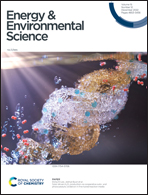Molten salt electrolytes for electrochemical capacitors with energy densities exceeding 50 W h kg−1†
Abstract
Electrochemical capacitors (ECs) are promising energy storage devices due to their superior power density and outstanding cycling stability. The development of EC electrolytes is of key importance to further promote their energy density and overall performance. Herein, we report molten salts as a new electrolyte category for ECs with superior performance. The molten-salt-based EC (MS-EC) device assembled with an AlCl3–NaCl–LiCl electrolyte and activated carbon electrodes provided an ultrahigh energy density of 50.4 W h kg−1 at a power density of 1.1 kW kg−1 at 125 °C. The energy storage process is clarified to follow a physisorption–chemisorption combined mechanism originating from electrolyte nanoconfinement effects. MS-ECs also demonstrate high cycling stability (99.8% capacitance retention after 10 000 cycles), low cost, and capability for long-duration energy storage (over 90% voltage retention after 25 days at room temperature). This study provides insights into the research on energy storage mechanisms and broadens the application field of ECs.



 Please wait while we load your content...
Please wait while we load your content...